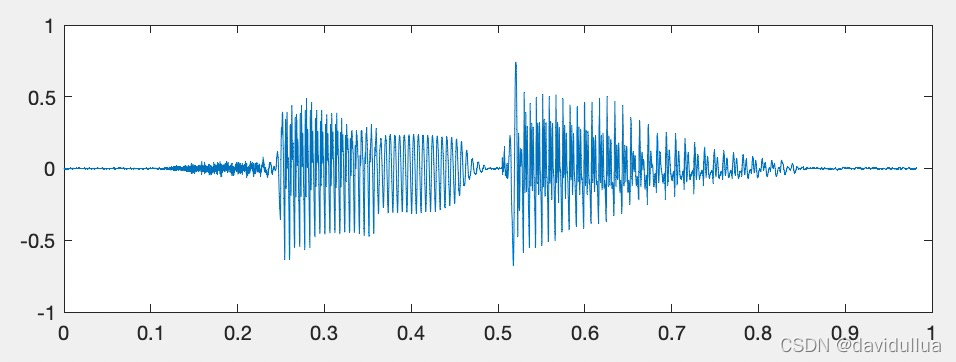本文分享如何在 matlab 里面读取 wav 文件,播放 wav 文件,以及如何录制语音文件,保存语音文件。
代码中演示了如何改变音频文件的采样率(影响到播放速度),音量(影响到听到的声音大小)。
以及录制的数据如何保存到文件中。 如果使用其他的编程语言,也能通过相关的函数类库达到类似的效果,比如 Python :Playing and Recording Sound in Python – Real Python
Matlab 2021 中读取 wav 文件
文件来自: ?http://mirlab.org/jang/books/audiosignalprocessing/example/sunday.wav?
[y, fs] = audioread('sunday.wav');
sound(y, fs); % Playback of the sound data (播放此音讯)
time=(1:length(y))/fs; % Time vector on x-axis (时间轴的向量)
plot(time, y); % Plot the waveform w.r.t. time (画出时间轴上的波形)画出的图形如下:

打印出音频文件的参数信息:
myAudioRead 库函数来自:?http://mirlab.org/jang/books/audiosignalprocessing/example.rar
fileName = 'welcome.wav';
au = myAudioRead(fileName);
y=au.signal; fs=au.fs; nbits=au.nbits;
fprintf('Information of the sound file "%s":\n', fileName);
fprintf('Duration = %g seconds\n', length(y)/fs);
fprintf('Sampling rate = %g samples/second\n', fs);
fprintf('Bit resolution = %g bits/sample\n', nbits);打印出来音频的总时长,采样率,采样位深(采样位分辨率)后,就可以进一步进行分析。
Matlab 中播放音频文件,播放3倍,15倍音量大小(震幅)的音频
au = myAudioRead('welcome.wav');
y=au.signal; fs=au.fs; nbits=au.nbits;
% 播放音频:Playback with original amplitude (播放 1 倍震幅的音訊)
audioPlay(au);
% Playback with 3 times the original amplitude (播放 3 倍震幅的音訊)
au.signal = 3*y;
audioPlay(au);
au.signal = 15*y;
audioPlay(au); % Playback with 15 times the original amplitude (播放 15 倍震幅的音訊)以不同采用率播放(不同速度播放)
% Playback at the original speed (播放 1.0 倍速度的音訊)
au.signal = y; % 恢复震幅
audioPlay(au);
% Playback at 0.8 times the original speed (播放 0.8 倍速度的音訊)
au.fs = 0.8*fs;
audioPlay(au);
% 播放 0.5 倍速度的音訊,像牛叫的声音
au.fs = 0.5*fs;
audioPlay(au);
% Playback at 1.2 times the original speed (播放 1.2 倍速度的音訊)
au.fs = 1.2*fs;
audioPlay(au);
% Playback at 2?times the original speed (播放 2?倍速度的音訊)?
au.fs = 2*fs
audioPlay(au);改变波形,比如把信号沿着x轴反转(y轴 * -1),再听声音, 听到的没有变化,说明声音的相位并不影响人的感知。
% Playback of the original signal (播放正常的音訊波形)
au.fs = fs;
au.y = y;
audioPlay(au);
% Playback of the up-down flipped signal (播放上下顛倒的音訊波形)
au.y = - y;
audioPlay(au);
% Playback of the left-right flipped signal (播放前後顛倒的音訊波形)
au.y = flipud(y);
audioPlay(au);?使用 audioplayer, play 来播放音频文件
apObj=audioplayer(y, fs);
apObj.SampleRate=16000; % Change the sample rate to 16000
play(apObj);
% 可以使用 doc play, doc audioplayer 来查看在线帮助,也可以使用 help 看命令行帮助。录制音频文件
% The commands wavplay and wavrecord are only supported in Microsoft Windows platform.
% audiorecorder(Fs, NBITS, NCHANS) creates an audiorecorder object
fs=16000; % Sampling rate (取樣頻率)
% duration=2; % Recording duration (錄音時間)
fprintf('Press any key to start %g seconds of recording...', duration); pause
fprintf('Recording...');
% y=wavrecord(duration*fs, fs); % duration*fs is the total number of sample points
% record audio, sample rate of fs, and 16 bit, 1 channel
r = audiorecorder(fs, 16, 1)
record(r)
% 等待一定时间
stop(r)
fprintf('Finished recording.\n');
fprintf('Press any key to play the recording...'); pause;
fprintf('\n');
p = play(r);前面的 record() 函数是异步录制, 执行之后代码继续运行,知道 stop()。 也可以同步录制,示例如下。
同步指定时长录制音频文件(录制5s)
fs=16000; % Sampling rate?
r = audiorecorder(fs, 16, 1) % sample rate of fs, and 16 bit, 1 channel
recordblocking(r, 5); % speak into microphone...
fprintf('Finished recording.\n');
fprintf('Press any key to play the recording...'); pause; fprintf('\n');
p = play(r);保存录制的音频文件?
可以通过如下代码,将前面录制的数据保存到 wav 文件。
% 保存录制的音频到文件
% nbits=16; % Bit resolution (每个采样点的信号量, 量化值的位数为 16-bit)
waveFile='test.wav'; % Wav file to be saved
% get sample data from recorder, get data as int16 array:
y = getaudiodata(r, 'int16');
% writes data Y to an audio file with name FILENAME, with a sample rate of FS Hz.
% AUDIOWRITE(FILENAME,Y,FS)
audiowrite(waveFile, y, fs);
fprintf('Finished writing %s\n', waveFile);